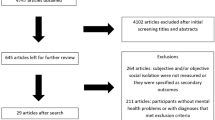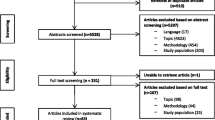Abstract
Purpose
For older adults, psychological adjustment has a great impact on successfully making the transition to living in a nursing home. However, a tailored Nursing Home Adjustment Scale (NHAS) for Chinese nursing home residents is not available. The aim of this study was to develop and psychometrically test properties of the NHAS for Chinese residents.
Methods
A total of 425 residents were recruited from 10 nursing homes from September 2017 to February 2018 in Fujian, China, to examine the psychometrics of the NHAS Chinese version. exploratory structural equation modeling (ESEM) was applied to evaluate the NHAS scale. Internal consistency, test–retest reliability, and construct validity were examined.
Results
The final structure for the NHAS was categorized into five domains, including emotional distress, relationship development, acceptance of new residence, depressed mood, and feeling at home. The goodness-of-fit indices of ESEM supported the five-factor model with satisfactory internal consistency (Cronbach’s α = 0.87) and test–retest reliability of 0.72 for the entire scale.
Conclusions
The Chinese version of the NHAS is a reliable and valid instrument to assess the level of nursing home adjustment among nursing home residents in China.
Similar content being viewed by others
References
World Health Organization. (2015). World report on ageing and health. https://apps.who.int/iris/bitstream/handle/10665/186463/9789240694811_eng.pdf?sequence=1.
National Bureau of Statistics of the People’s Republic of China. (2017). http://www.stats.gov.cn/tjsj/zxfb/201802/t20180228_1585631.html.
Shum, M. H., Lou, V. W., He, K. Z., Chen, C. C., & Wang, J. (2015). The “leap forward” in nursing home development in urban China: Future policy directions. Journal of the American Medical Directors Association, 16(9), 784–789. https://doi.org/10.1016/j.jamda.2015.04.010.
Johnson, R. A., & Bibbo, J. (2014). Relocation decisions and constructing the meaning of home: A phenomenological study of the transition into a nursing home. Journal of Aging Studies, 30, 56–63. https://doi.org/10.1016/j.jaging.2014.03.005.
Oswald, F., & Wahi, W. H. (2005). Dimensions of the meaning of home. In G. D. Rowles & H. Chaudhury (Eds.), Home and identity in late life: International perspectives (pp. 21–45). New York: Springer.
Brandburg, G. L. (2007). Making the transition to nursing home: A framework to help older adults adapt to the long-term care environment. Journal of Gerontological Nursing, 33(6), 50–56.
Corrigan, J. D., Kolakowsky-Hayner, S., Wright, J., Bellon, K., & Carufel, P. (2013). The satisfaction with life scale. The Journal of Head Trauma Rehabilitation, 28(6), 489–491. https://doi.org/10.1097/HTR.0000000000000004.
Johnson, B. D., Stone, G. L., Altmaier, E. M., & Berdahl, L. D. (1998). The relationship of demographic factors, locus of control and self-efficacy to successful nursing home adjustment. Gerontologist, 38(2), 209–216.
Lee, G. E. (2010). Predictors of adjustment to nursing home life of elderly residents: A cross-sectional survey. International Journal of Nursing Studies, 47(8), 957–964. https://doi.org/10.1016/j.ijnurstu.2009.12.020.
Schneider, F. W., & Coppinger, N. W. (1971). Staff-resident perceptions of the needs and adjustment of nursing home residents. Aging and Human Development, 2(1), 59–65. https://doi.org/10.2190/AG.2.1.g.
Lee, G. E. (2007). Scale development of free nursing home-adjustment for the elderly. Journal of Korean Academy of Nursing, 37(5), 736–743.
Lee, G. E., Yoon, J. Y., & Bowers, B. J. (2015). Nursing home adjustment scale: A psychometric study of an English version. Quality of Life Research, 24(4), 993–998. https://doi.org/10.1007/s11136-014-0836-z.
World Health Survey. (2002). Individual questionnaire. Beijing: World Health Organization.
Diener, E., Emmons, R. A., Larsen, R. J., & Griffin, S. (1985). The satisfaction with life scale. Journal of Personality Assessment, 49(1), 71–75.
Katz, S. (1963). Studies of illness in the aged-the index of ADL: A standardized measure of biological and psychosocial function. JAMA, 185(12), 914–919. https://doi.org/10.1001/jama.1963.03060120024016.
Dorcas, E., Beaton, C. B., Guillemin, F., & Ferraz, M. B. (2000). Guidelines for the process of cross-cultural adaptation of self-report measures. Spine, 25(24), 3186–3191.
Pfeiffer, E. (1975). A short portable mental status questionnaire for the assessment of organic brain deficit in elderly patients. Journal of the American Geriatrics Society, 23(10), 433–441. https://doi.org/10.1111/j.1532-5415.1975.tb00927.x.
Streiner, D. L., Norman, G. R., & Cairney, J. (2015). Health measurement scales: A practical guide to their development and use. New York: Oxford University Press.
Kline, P. (1986). A handbook of test construction: Introduction to psychometric design. New York: Methuen.
Beauducel, A., & Herzberg, P. Y. (2006). On the performance of maximum likelihood versus means and variance adjusted weighted least squares estimation in CFA. Structural Equation Modeling: A Multidisciplinary Journal, 13(2), 186–203.
Daire Hooper, J. C., & Mullen, Michael R. (2008). Structural equation modelling: Guidelines for determining model fit. Electronic Journal of Business Research Methods, 6(1), 53–60.
Hu, L. T., & Bentler, P. M. (1999). Cutoff criteria for fit indexes in covariance structure analysis: Conventional criteria versus new alternatives. Structural Equation Modeling: A Multidisciplinary Journal, 6(1), 1–55. https://doi.org/10.1080/10705519909540118.
Marsh, H. W., Hau, K.-T., & Wen, Z. (2004). In search of golden rules: Comment on hypothesis-testing approaches to setting cutoff values for fit indexes and dangers in overgeneralizing Hu and Bentler’s (1999) findings. Structural Equation Modeling: A Multidisciplinary Journal, 11(3), 320–341. https://doi.org/10.1207/s15328007sem1103_2.
Devon, H. A., Block, M. E., Moyle-Wright, P., Ernst, D. M., & Kostas-Polston, E. (2007). A psychometric toolbox for testing validity and reliability. Journal of Nursing Scholarship, 39(2), 155–164. https://doi.org/10.1111/j.1547-5069.2007.00161.x.
Kurtz, J. E. (2017). Test-retest reliability. In V. Zeigler-Hill & T. K. Shackelford (Eds.), Encyclopedia of personality and individual differences (pp. 1–2). Cham: Springer.
Wilson, S. A. (1997). The transition to nursing home life: A comparison of planned and unplanned admissions. Journal of Advanced Nursing, 26(5), 864–871.
Drageset, J., Espehaug, B., & Kirkevold, M. (2012). The impact of depression and sense of coherence on emotional and social loneliness among nursing home residents without cognitive impairment—A questionnaire survey. Journal of Clinical Nursing, 21(7–8), 965–974. https://doi.org/10.1111/j.1365-2702.2011.03932.x.
Ellis, J. M. (2010). Psychological transition into a residential care facility: Older people’s experiences. Journal of Advanced Nursing, 66(5), 1159–1168. https://doi.org/10.1111/j.1365-2648.2010.05280.x.
Kaldyand, J., & Tarnove, L. (2002). A clinical practice guideline approach to treating depression in long-term care. Journal of the American Medical Directors Association, 3(2), 103–110.
Mezuk, B., Lohman, M., Leslie, M., & Powell, V. (2015). Suicide risk in nursing homes and assisted living facilities: 2003-2011. American Journal of Public Health, 105(7), 1495–1502. https://doi.org/10.2105/AJPH.2015.302573.
Seeman, T. E., Lusignolo, T. M., Albert, M., & Berkman, L. (2001). Social relationships, social support, and patterns of cognitive aging in healthy, high-functioning older adults: MacArthur studies of successful aging. Health Psychology, 20(4), 243–255.
Bitzan, J. E., & Kruzich, J. M. (1990). Interpersonal relationships of nursing home residents. Gerontologist, 30(3), 385.
Williams, K. L., & Galliher, R. V. (2006). Predicting depression and self-esteem from social connectedness, support, and competence. Journal of Social and Clinical Psychology, 25(8), 855–874.
Wolff, F. (2013). Well-being of elderly people living in nursing homes—The benefits of making friends. Kyklos, 66(1), 153–171.
Barkay, A., & Tabak, N. (2002). Elderly residents’ participation and autonomy within a geriatric ward in a public institution. International Journal of Nursing Practice, 8(4), 198–209.
Cooney, A. (2012). ‘Finding home’: A grounded theory on how older people ‘find home’ in long-term care settings. International Journal of Older People Nursing, 7, 188–199.
Asparouhov, T., & Muthén, B. (2009). Exploratory structural equation modeling. Structural Equation Modeling: A Multidisciplinary Journal, 16(3), 397–438. https://doi.org/10.1080/10705510903008204.
Acknowledgements
We are grateful to the residents who provided their time and participated in this study. Many thanks to Lee, G.E. and Yoon, J.Y., for their help and support.
Funding
This research received no specific grant from any funding agency in the public, commercial, or not-for-profit sectors.
Author information
Authors and Affiliations
Contributions
HX: conception and design of the study, critical revision of the manuscript, and supervision. BY: acquisition of data, analysis and interpretation of data and drafting the manuscript. XL: acquisition of data, analysis and interpretation of data. YL: acquisition of data, analysis and interpretation of data.
Corresponding author
Ethics declarations
Conflict of interest
We have no financial or non-financial conflicts of interest to report.
Ethics approval
This survey was approved by the human ethics committee of Fujian Medical University.
Informed consent
Informed consent was obtained from all individual participants included in the study.
Additional information
Publisher's Note
Springer Nature remains neutral with regard to jurisdictional claims in published maps and institutional affiliations.
Rights and permissions
About this article
Cite this article
Xiao, H., Yong, B., Liu, X. et al. A psychometric evaluation of the Chinese version of the Nursing Home Adjustment Scale. Qual Life Res 28, 2535–2542 (2019). https://doi.org/10.1007/s11136-019-02192-y
Accepted:
Published:
Issue Date:
DOI: https://doi.org/10.1007/s11136-019-02192-y




